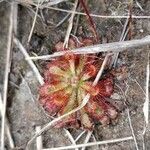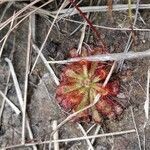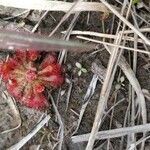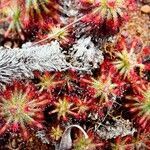Herbs perennial, with 1 or 2 black, fibrous roots. Stem short, sometimes to 0.5 cm when growing in Sphagnum moss, forming a tightly rosulate bulb during winter in temperate climates, not forming a tuber below ground. Leaves forming a dense, flat rosette, circinately 1-folded toward stipule when young; stipule light red, narrow, 4-8 mm, scarious, apex fimbriate, setaceous; petiole flattened, gradually dilated distally, 8-10 mm, glandular hairy; leaf blade obovate, spatulate, or cuneate, 0.9-2.8 cm × 2-5 mm, glandular hairy. Inflorescences 1-6, scapiform, sometimes branched, 4-25 cm; peduncle densely glandular hairy; racemes 1-sided, 10-20-flowered; bracts subulate to linear-lanceolate, ca. 2 mm or more, 3-parted; pedicels 0.5-3 mm. Sepals 5, united at base, green, lanceolate or narrowly ovate, 1.5-4 mm, margin entire or l-toothed, densely glandular hairy abaxially. Petals white or pink to reddish violet, obovate, 2-6 mm or more. Stamens 5, 2.5-6 mm; filaments flat, ca. 5 mm; anthers oblong, ca. 1.5 mm. Ovary ellipsoid-globose; placentas 3(or 4); styles 3(or 4), ca. 2.5 mm, each style deeply 2-parted to base, sometimes again parted distally; stigma simple, persistent. Capsule 3(or 4)-valved, ca. 1.5 mm; valves obdeltoid, incurved. Seeds black, ovoid or ellipsoid, small; venation thick and scrobiculate. Fl. and fr. Mar-Sep. 2n = 20, 40, 60.
More
Herb with fibrous roots. Stem very short. Leaves crowded in a flat rosette; lamina spathulate, narrowed to broad, flat petiole, the whole 8–20 mm long; stipules narrow, 5–7 mm long, laciniate. Inflorescences 1–5, racemose, 1-sided, rarely branched, up to 24 cm long with up to 15 flowers, glandular; bracts linear-lanceolate, 1–2.5 mm long; pedicels 0.5–3 mm long. Calyx 2–5 mm long, deeply divided into narrowly oblong, acute lobes, with glandular minute hairs. Petals obovate, 3.5–6 mm long, white or pink. Styles 3, bipartite to base, the segments sometimes dilated.




